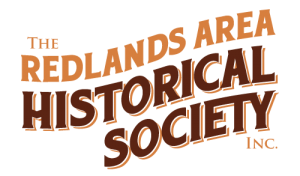
2023 HERITAGE AWARD RECIPIENT
The Redlands Area Historical Society, Inc.
George S. Gay Home “Valmira”
31674 E. Citrus Avenue
1892
George Sinclair Gay (1850-1933) was the son of a second-generation whaling vessel captain, a Scotsman from Crail, Fifeshire. As a young teenager, his family along with members of the Sinclair and Robinson clan, sailed to Hawaii from New Zealand in search of land suitable for raising sheep and cattle. The family purchased the island of Niihau, a remote island in the Hawaiian chain from King Kamehameha V. George married Marion Rowell, the daughter of missionaries in 1879. George formed the Gay-Robinson Sugar Plantation at Makaweli, Kauai that remained in business producing sugar cane until September 10, 2008. George met Herbert H. Garstin, who became the company manager along with his new wife, Maud Knudsen. George was appointed District Judge for Niihau.
The family tried Canada, Oregon and other locations before moving here. George moved to Crafton after members of the George Dole pineapple family that was living in Riverside, suggested the location. George and Marion sought good schools for Harold, Ethel, Norman and Leslie their children. An unusual drought was also part of the move decision.
County archives record Gay from the Sandwich Islands paid $12,000 for the land and water rights for two ditches owned by Abner Eason since 1881. William P. McIntosh, the developer of Mentone, was the realtor for the transaction. George Gay rented the William Tench home in Mentone while his home was built at Valmira which means “Valley View.” George hired Horace and Rachel Harrol (negros) for $50 per month working six days a week, nine hours a day, doing ranch work. One field ledger records two Serrano natives planted fruit trees on forty acres in 1892.
The $4,000 home was completed in 1892 facing north. Victorian architecture is stick-style with double hung windows, a wrap-around porch with balustrade and decorative brackets, shiplap siding, fish-scale shingles, two story bay windows and a steep gabled roof. Harold and Ethel are shown on the front steps. Three of the children rode burrows to Crafton School on Wabash and the Zanja. The first barn is shown on the left side of a 1892 photo. Washingtonia Palms lined the driveway from East Citrus to the sycamore tree planted in the only grass patch of Crafton for decades.
The first home proved inadequate for many family relations moving from Hawaii to Crafton. George planned the extensive addition in February of 1896 as reported in The Citrograph newspaper. The Victorian morphed into a Queen Ann with the appropriate tower. Ashlar cut stone foundation and awnings to protect the interior furniture. Family relations bought orange groves all within a short distance of Valmira. The wood barn burned down in 1907 and was replaced by the current barn in 1908. The new barn led to changes in the driveway configuration. A south door entrance was built with cobblestone foundation.
George bought a building in Los Angeles and rented rooms for additional income. With his brother, Francis, they bought waterfront property at Lake Tahoe and occupied one of the original 1883 dam builders’ cabins in Big Bear. George became a founder of the Redlands Orange Grower’s Association and served on the board with Herbert Garstin. George expanded Valmira Ranch with an irrigation system planting 100 acres of navels and Valencias. He planted camellias, wisteria, jacaranda, eucalyptus, and iris. Walnuts, grapes, pecans, olives, peaches, plums, pears, figs, apples and avocados adorned the ranch. Blackberries, raspberries, strawberries, tangerines, lemons and grapefruit were all planted near the home. Alfalfa was planted in the Crafton hills to feed the farm animals.
George was an athlete. With his son, Leslie, he helped establish the Redlands Country Club. Marion was a founding member of the Contemporary Club and a member of the Crafton Women’s Club and Indian Association. When Marion died in 1912, George moved to Coronado and developed property on Ocean Boulevard. He was elected Vice-Commodore of the Coronado Yacht Club. He bought a 36-foot sloop and won the Lipton Cup several times in the San Diego Yacht Club races in 1923. He acquired the “Aloha” which continued his winning streak. George died in 1933 with his obituary printed in the Daily Facts on the day of his death.
Leslie Rowell Gay (1885-1982) attended Crafton Elementary and Redlands High School and sat behind his future wife, Margaret. Leslie attended Stanford University with his brother majoring in geology and mining engineering. Kenneth Dole and brothers George and Sanford shared rooms in a fraternity house. In college Leslie was captain of the rowing team and a winning tennis player.
Upon graduation Leslie went to Mexico and worked for the Anglo Continental Gold Syndicate. He conducted assay samples and oversaw mining activities. For fun he hunted ducks and became quite a sharpshooter. In the 1920s he founded the Delta Duck Club at the Salton Sea with fellow Redlanders.
Leslie returned to manage Valmira in 1910 and became an expert in citrus propagation. He invented a method to control Armillaria root rot that proved effective without chemicals. He became a director of the Crafton Water Company and the Bear Valley Mutual Water Company. He was the first president of the Bear Valley Development Co. that was tasked to sell water company land around Big Bear Lake. He was also president of the Redlands Orange Growers Association founded by his father and in 1939 elected chairman of the Redlands-Highlands Citrus Center.
As an athlete Leslie participated in four sports at Redlands High. In 1940, with his son, Francis, he won the United States Tennis Association Father and Son tournament at Chestnut Hill. He won championships at the La Jolla Tennis Club, Pasadena tournament, Santa Monica, Canadian Nationals, Victoria and Terminal Island singles. He continued competitive play in 1963 winning the Redlands doubles tournament. Leslie was elected president of the Redlands Country Club in 1931. Leslie and Margaret had three sons Francis, John and Phillip. Leslie built a new home 10770 “B” Street in 1954.
Margaret wanted to modernize the Victorian home. The Queen Ann tower was removed in the 1920s and the home exterior became more like a Classic Box.
Philip Leslie Gay (1912-2001) went to Crafton School, Redlands Junior High and Redlands High. He rode a bicycle to Wabash Avenue and then took the trolley car to school. He enjoyed chemistry, machine shop and playing golf. Upon graduation he was employed by the packing houses on East Colton Avenue and Greenspot for $0.18 cents an hour for a ten-hour day, six days a week.
Philip was drafted in 1942 receiving training at Yale University. He was commissioned as a second lieutenant specializing in Norden bombsight hardware. He met his future wife, Mary Francis Finnigan, while a cadet at Yale. They corresponded with each other and married one month after the war ended in 1945 at St. Joseph Catholic Church in New Haven.
Philip came back to Valmira and ranched 115 acres of navel and Valencias. Leslie had added 15 acres of Santa Rosa plums in the nearby hills that became farm responsibilities. Philip continued using work horses until 1966. He adopted the no-till soil technique to conserve water. He kept detailed records from eight different plots from the 1930s to 1980s. He could show strong correlation between increasing smog concentrations measured by the University of California, Riverside.
Philip and Mary had four children, Charles, Richard, Robert and Alice. All three sons earned PHDs in Chemistry, Chemical Engineering at U.C. Riverside, UCLA and MIT. Mary died of cancer in 1961 and Philip married Josephine Van Scoy and then Valeta Brazel. Valeta and Philip were both avid golfers. Philip won the Country Club Gold title in 1936. Playing continuously into his 80s he won numerous golf trophies. He played weekly with a 6:00 a.m. starting time.
Philip served as scoutmaster for Boy Scout Troop 10 with headquarters in Greenspot. He loved fishing and hiking the Santa Ana Canyon for trout pools. He used native earthworms and natural bugs for bait.
Dr. William James Hopewell and his wife Charlotte bought the 21.6-acre ranch and home in 1989 for $400,000. Dr. Hopewell practiced at the Beaver Medical Clinic. Locating original blueprints of the Queen Ann home, the two were motivated to return Valmira to its original glory. They hired Derwin Waters, a draftsman and carpenter to prepare plans. They built a new car barn in 1987. This was followed by restoring the Queen Ann tower with Victorian gingerbread as in 1896. Waters took the frame of the tower placing the new structure on the southwest corner of the home. The south doorway with the cobblestone foundation was removed. Ashlar-cut granite was located to replace foundation walls. The paint and gingerbread restoration went on until the 1892 spirit returned to the building. Plumbing and electrical came into this century along with a pool. The 4,193 square foot home has 4 bedrooms and now 4 ½ baths all completed for use.
In 2012, Scott Mercer, a Dell Computer finance manager from Silicon Valley, purchased the home for $2.3 million. Scott is a 1969 graduate of Redlands High. He built barns for his growing car collection. A solar panel farm reduced the cost of electricity for the well and outside lighting. When the cedar tree that was planted in 1912 to commemorate the birth of Philip Gay died, Scott hired an artist that chain-sawed Gandolf on the west lawn. The palm driveway shared with Larry Jacinto was planted with flowers and now has a ribbon of grass. The barbecue area and patio lounge were completed. “B” Street was graded with pavers the entire distance. A 1950 GMC pickup is painted with Valmira on the door. From the front gate the home presents 1890 charm. The front lawn faces west with a view of the valley. The north side has the brackets supporting the porch. The east side reveals less Victorian motifs but the 1896 expansion is apparent.
Scott and Kathy married in 2020. Kathy has caught the local history disease and has spread her interest to all the area. She has researched the Gay family back to Scotland. Derwin Waters remains working on the property with a studio in the 1908 barn. Scott won a previous Heritage Award in 2008 for the Walter H. and Clare Blodget home at 1850 Rossmont Drive. Scott and Kathy certainly deserve a 2023 Heritage Award for this showcase home.
Research by Tom Atchley, Kathy Mercer and Charles Gay
Presented 12 June 2023

